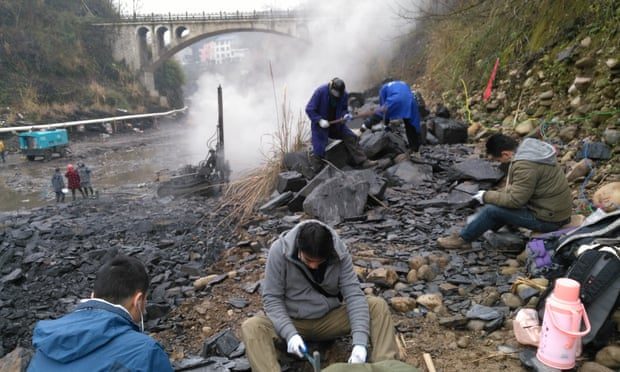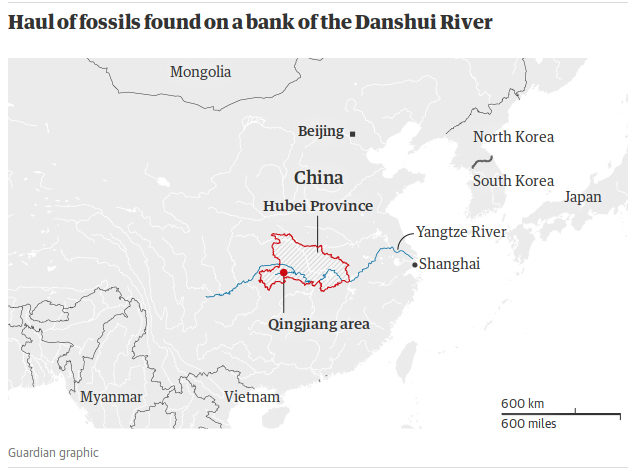
Paleontologists found thousands of fossils in rocks on the bank of the Danshui river in Hubei province in southern China, where primitive forms of jellyfish, sponges, algae, anemones, worms and arthropods with thin whip-like feelers were entombed in an ancient underwater mudslide.
The creatures are so well preserved in the fossils that the soft tissues of their bodies, including the muscles, guts, eyes, gills, mouths and other openings are all still visible. The 4,351 separate fossils excavated so far represent 101 species, 53 of them new.
"It is a huge surprise that such a large proportion of species in this fossil assemblage are new to science," said Robert Gaines, a geologist on the team from Pomona College in Claremont, California. The fieldwork was led by Xingliang Zhang and Dongjing Fu at Northwest University in Xi'an, 700 miles (1,127km) south-west of Beijing.

Scientists still debate what prompted the Cambrian explosion. One idea is that life stumbled upon the genetic tools to build animal bodies, but the onset of predation, which triggered an evolutionary arms race, shifts in tectonic plates, and a surge of nutrients into the oceans, may also have played a part.
Until now, the most impressive fossils from the Cambrian explosion were those found in the Burgess Shale, a 508m-year-old rock formation in Canada, and in the 518m-year-old Chengjiang formation in China. The new fossils, found near the junction of the Danshui and Qingjiang rivers in Hubei province in China, provide a snapshot of a radically different ecosystem of organisms that lived around the same time.
During the Cambrian explosion, all animal life existed in the sea. Writing in the journal Science, the researchers describe how the Qingjiang organisms were engulfed by a submarine mudflow that swept them into deeper, colder water. There, buried in fine sediment, the normal process of decay was halted, leading to their exceptional preservation.
Martin Smith, a paleontologist at Durham University who was not involved in the work, said the new site was remarkable for capturing a profoundly important time in evolutionary history in such incredible detail. "Its preservational quality is mindblowing," he said. "If you sent a time traveler back to the Cambrian period armed with a camera and an x-ray machine, the images they'd come back with would be nothing compared to these fossils, which preserve detail finer than a human hair.
"These fossils help us to piece together the steps that evolution took as animals evolved from whatever squishy blob represents their common ancestor to the rich diversity of lineages alive today," he added. "Because some of the preserved organisms are much simpler than their living relatives, they help us to tease apart how complex organs such as brains could be assembled through blind evolutionary processes."
Allison Daley, a paleontologist at the University of Lausanne, said two species in the fossil haul stood out to her. The first was a kinorhynch, otherwise known as a mud dragon. Today, these worm-like creatures grow to a few millimetres long and live in soft mud. But the fossilised mud dragons were up to 4cm long. "I don't think anyone would have predicted that they started out as such big animals," she said.
Another surprise, Daley said, was the sheer number of comb jellies found at the site. These carnivorous marine creatures are one of the most primitive on the tree of life, and studying them could help scientists retrace some of the first steps in animal evolution. In an article accompanying the study, she calls the new fossils "stunning".
"It's not just the quality of the fossils that is amazing, it's the abundance," Daley said. "In all my career, I never thought I would see and witness the discovery of a site this good. If you were to make a dream wish-list of what you would want to see in a new Cambrian fossil site, this would be it. This is just the first of what will undoubtedly be a series of high-profile papers revealing all sorts of answers to mysteries about the Cambrian animals."





Comment: For more on the Cambrian period and how evolution probably didn't 'stumble' into anything, see:
- New paper confirms trilobite explosion during Cambrian - appeared out of nowhere with no visible ancestors
- In Cambrian Explosion Debate, Intelligent Design Wins by Default
- Michael Behe: One man's battle with Darwinian evolution
See also:- Is a catastrophic event 200,000 years ago responsible for most of the life on our planet today?
- Dinosaurs appeared much earlier, then their numbers exploded during planetary upheaval and mass extinction event
And check out SOTT radio's: